The name “milkweed” may not sound pretty, but milkweeds themselves produce lovely, colorful blooms each year.
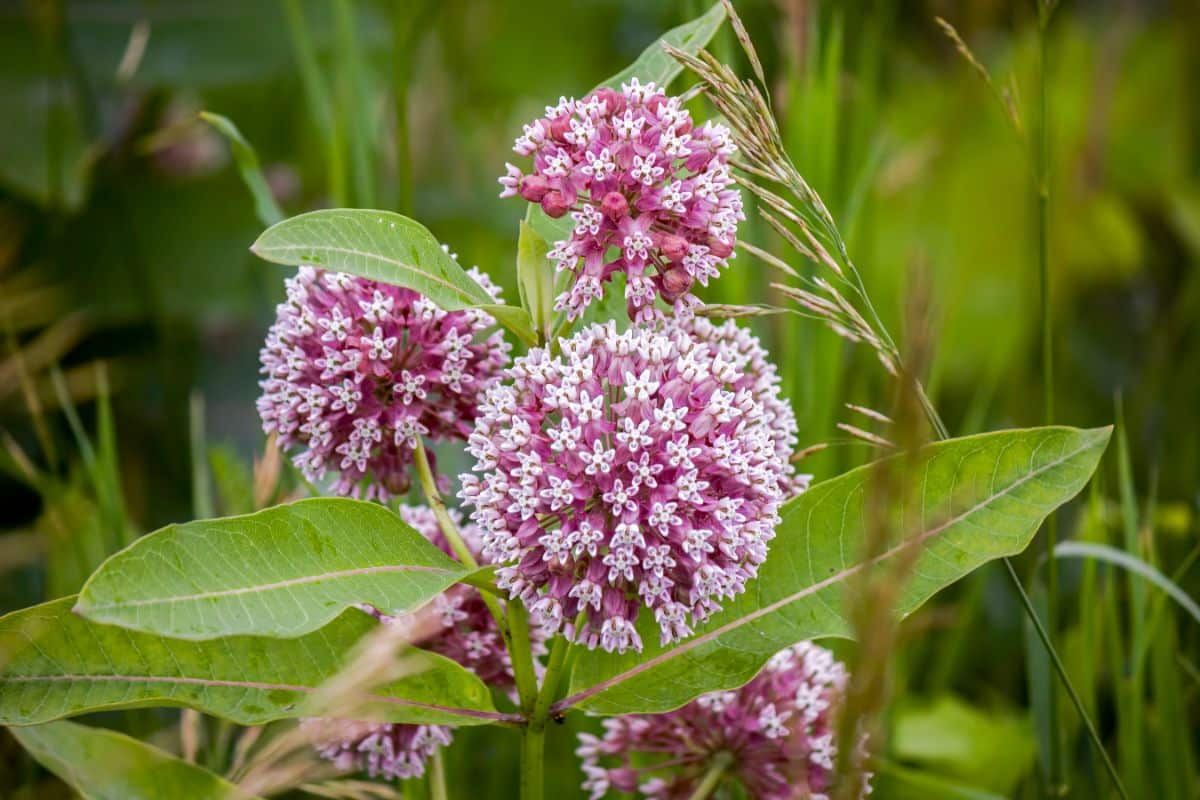
But where milkweed really shines is in attracting something else beautiful to your garden—butterflies!
In this growing guide, you will learn everything you need to know to get started with milkweed in your flower beds and pots.
Just need the answer to a specific question about growing milkweed? Jump to any section below in our advanced jump for fast answers.
Jump to:
- What Are Milkweeds?
- Attract Monarchs to Your Garden with Milkweed
- Milkweed Basics
- Where Do Milkweeds Grow?
- Why Grow Milkweeds?
- When Do Milkweeds Bloom?
- How Long Do Milkweeds Bloom?
- When to Plant Milkweeds
- Ideal Growing Conditions for Milkweeds
- How to Plant Milkweeds
- How to Propagate Milkweeds
- How to Care for Milkweeds
- Recommended Planting Combinations for Milkweed
- Milkweed Landscaping Ideas
- Recommended Milkweed Varieties
- Milkweed Varieties to Avoid
- Frequently Asked Questions About Growing Milkweeds
- Where to Buy Milkweeds
What Are Milkweeds?
Milkweed is the common name for plants in the genus Asclepias, all of which are perennials.
They produce a milky substance that is called “latex.” This is what the name refers to.
Despite the fact that they are called “milkweeds,” these plants are not considered to be weeds in their native range. On the contrary—since they are native plants in the Americas, they are a go-to choice for ecologically-minded gardeners.
You will be interested to learn that the flowers of milkweed plants are considered to be among the most complex in existence.
Interestingly enough, milkweeds can yield some useful materials. To start with, it is possible to make rope and fabric out of the fibers from milkweed stems. And then there is the floss in the seedpods; in a pinch, it can serve as a stuffing material.
Almanac says, “During World War II, the regular material used to stuff life jackets was in short supply, so milkweed floss was used as a substitute—it is about six times more buoyant than cork.”
Attract Monarchs to Your Garden with Milkweed
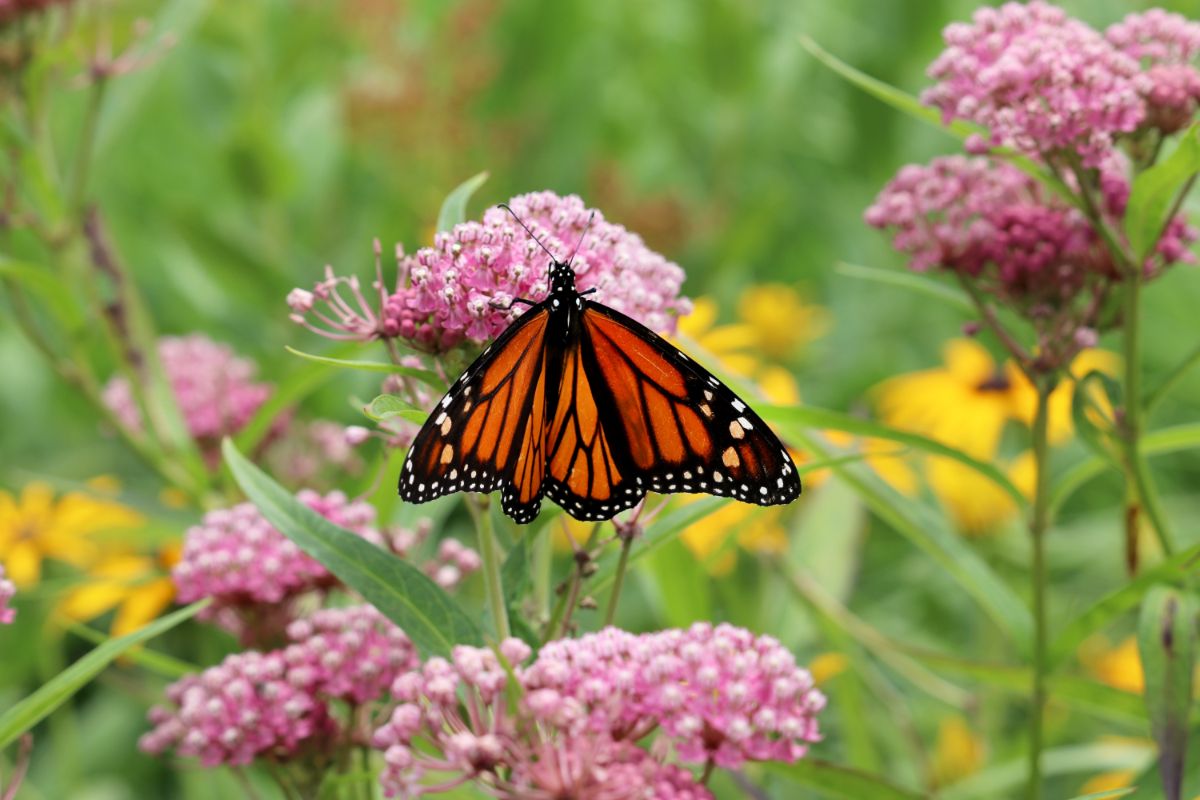
What milkweeds are most famous for is their critical importance to the lifecycle of the monarch butterfly.
You might remember from grade school learning that butterfly larvae eat milkweed leaves. But did you know that is the only food these caterpillars can consume? Imagine how hard it would be to get by if there was only one type of food you could eat!
If you think you remember seeing lots of monarch butterflies as a kid but hardly any nowadays, you are not imagining it. These butterflies are now endangered. In the past two decades alone, there has been an 85% drop in their population. So, it is very important to take all threats to their populations seriously.
The National Wildlife Federation writes, “Eradication of milkweed both in agricultural areas as well as in urban and suburban landscapes is one of the primary reasons that monarchs are in trouble today.”
Growing appropriate milkweed plants for your region is one way you can help these beautiful butterflies survive.
Milkweed Basics
| Zones: | 4-9 |
| Blooming season: | Late spring through fall |
| Expected height: | Up to 6 feet |
| Soil: | Average, well-draining soil |
| Sun: | Full sun |
Where Do Milkweeds Grow?
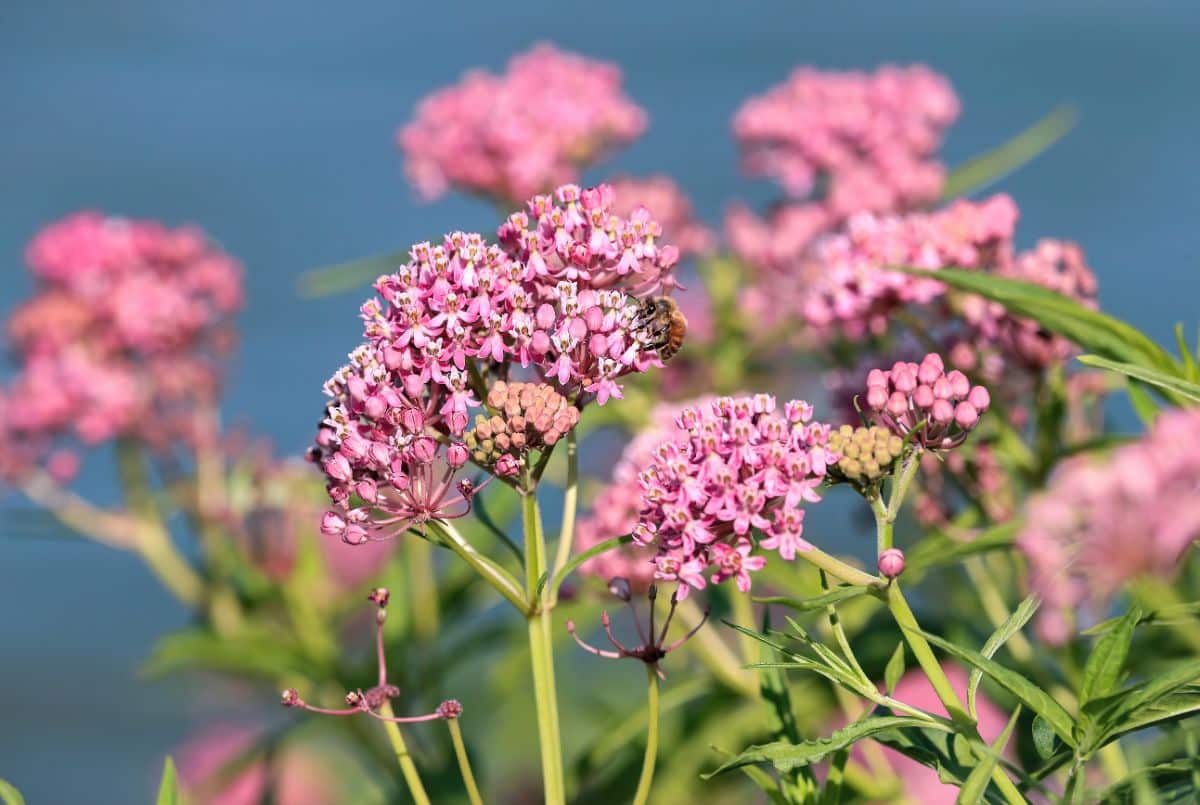
Milkweed can be found growing in North America, Central America, South America and Africa.
If you want to plant milkweed in the US, you should be aware that maintaining tropical milkweed in your garden year-round may disrupt the migration patterns of monarch butterflies. This can lead to a population overgrowth of a parasite called Ophryocystis elektroscirrha. That doesn’t do any favors for the afflicted butterflies.
You can avoid contributing to this problem simply by choosing types of milkweed for your garden native to your region.
Why Grow Milkweeds?
Here are some of the benefits of planting milkweed in your garden:
• Milkweed is an excellent choice for native plantings. In the US, there are more than 100 native species to choose from!
• When you grow native milkweed for your region, you give the monarch butterflies and larvae the food they need to survive. Along with helping these endangered insects, you will also attract other butterflies as well as bees to pollinate in your garden.
• Milkweed is the ultimate drought-tolerant plant. If you have an arid climate, most species of milkweed will be happy there.
• With so many varieties of milkweed, you will find a wide range of colors to choose from. There is something to complement any garden bed.
• Although milkweed prefers dry soil and full sun, there are some species that can tolerate shade and which prefer moist soil. That means that regardless of your conditions, you can probably find a suitable type of milkweed to plant in your garden.
• Milkweeds are really low-maintenance plants. They only require fertilizing once a year; they do not need much in the way of watering, and pruning them is simple. Often, mulch is not required either. So, if you have been looking for a plant you can grow easily without a huge investment of time and energy, this is one of the best perennials out there.
• There are a variety of options for propagating milkweeds. That means that you can save money growing new milkweed plants in the future.
When Do Milkweeds Bloom?
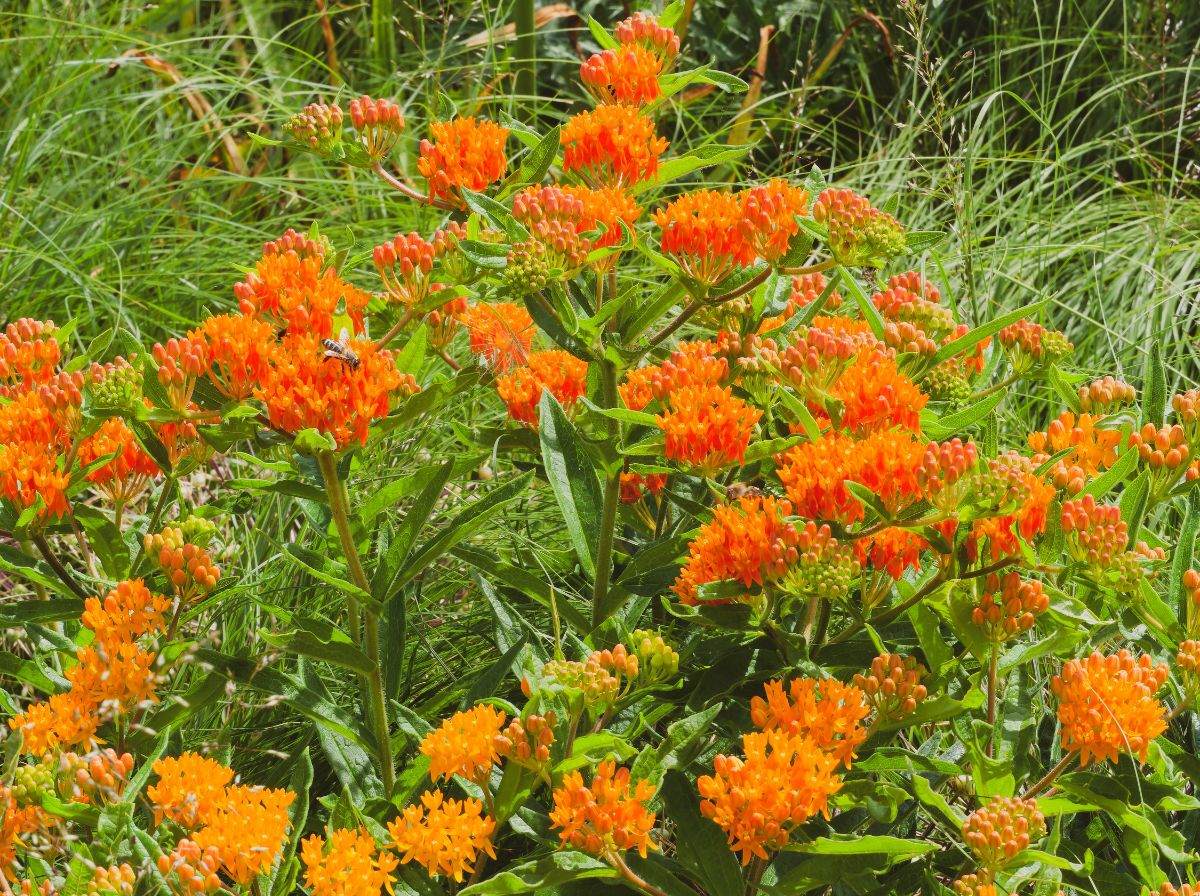
Milkweeds may bloom as early as spring and as late as fall, with the peak being summer. The exact months you can expect your milkweed to bloom will depend on what variety you have.
How Long Do Milkweeds Bloom?
Milkweeds can bloom for months. Deadheading them will encourage the production of more blooms throughout the growing season.
When to Plant Milkweeds
Plant milkweed during spring. Wait until the last frost has passed, and then proceed.
Ideal Growing Conditions for Milkweeds
If you want milkweeds to flourish in your garden, then you need to grow them in conditions that are suitable for them. Let’s go over water, sun, and soil requirements for these perennials.
How Much Sun Do Milkweeds Need?
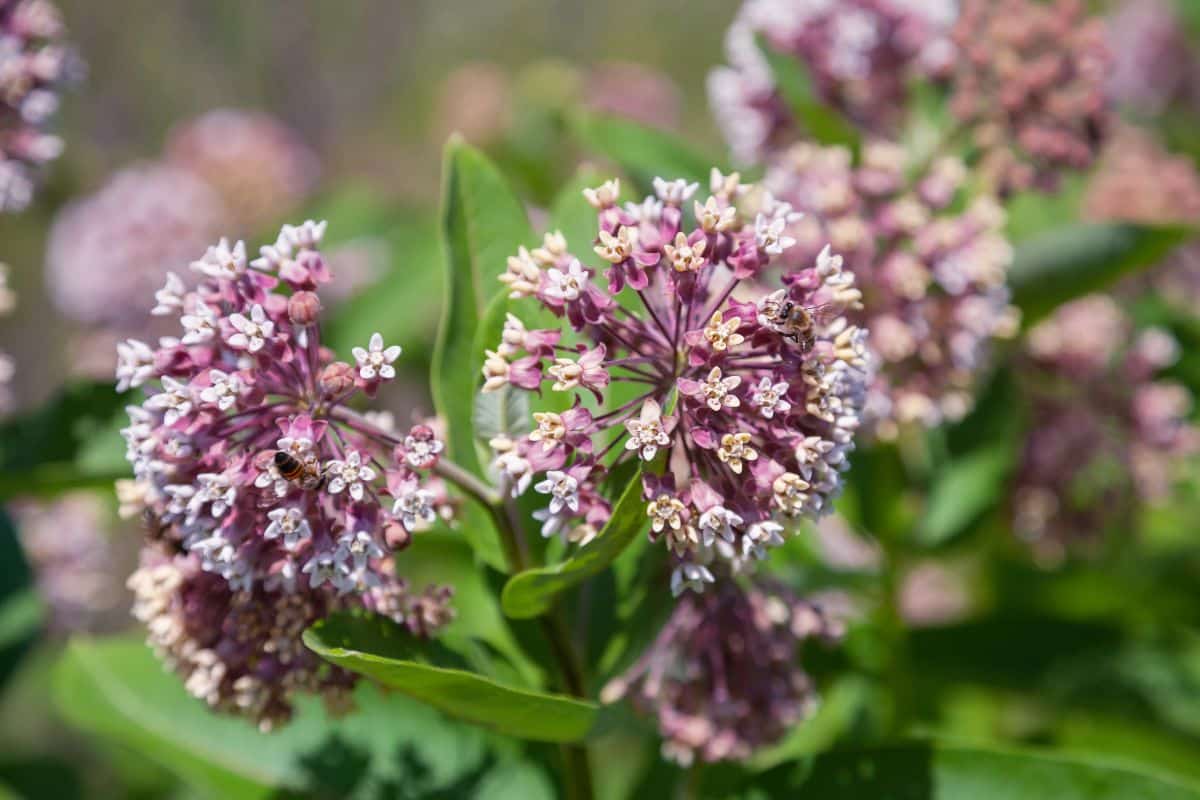
Milkweeds are definitely not shade plants. Plant them in full sun when possible. Some light afternoon shade may also be okay, especially if you have a hot climate.
What Type of Soil is Right for Milkweeds?
Milkweeds are flexible when it comes to soil types. The majority prefer dry soil. Poor or average soil is preferable to rich soil, though it is good to amend with a bit of compost when you plant.
One type of milkweed that actually wants soil to be on the rich and moist side is swamp milkweed. So, keep that in mind if that is the variety you are planting. “Moist” does not mean soggy; however, try to plant milkweeds where they will get good drainage.
Slightly to moderately acidic soil is best for these plants, so you may need to take steps to adjust pH if your soil is alkaline. Some options include compost, iron sulfate, sulphur, and peat moss.
How Much Water Do Milkweeds Need?
One area where milkweeds are particularly undemanding in their care is with respect to watering.
These plants usually do not need watering at all except during dry spells. Check the soil to see if the top couple of inches are dry. If they are, then it is time to water your plant.
When watering, provide 1-2 inches rather than the 1 inch that most perennials require.
One important precaution is to never overwater your milkweeds. It is easier to overwater these plants than you might think; milkweeds are very susceptible to fungal infections, so this is a common newbie mistake that can lead to sick plants.
The milkweeds you plant in containers may need a little bit more water than those that are in your garden beds, but it is also important not to overdo it with these potted plants either.
How to Plant Milkweeds
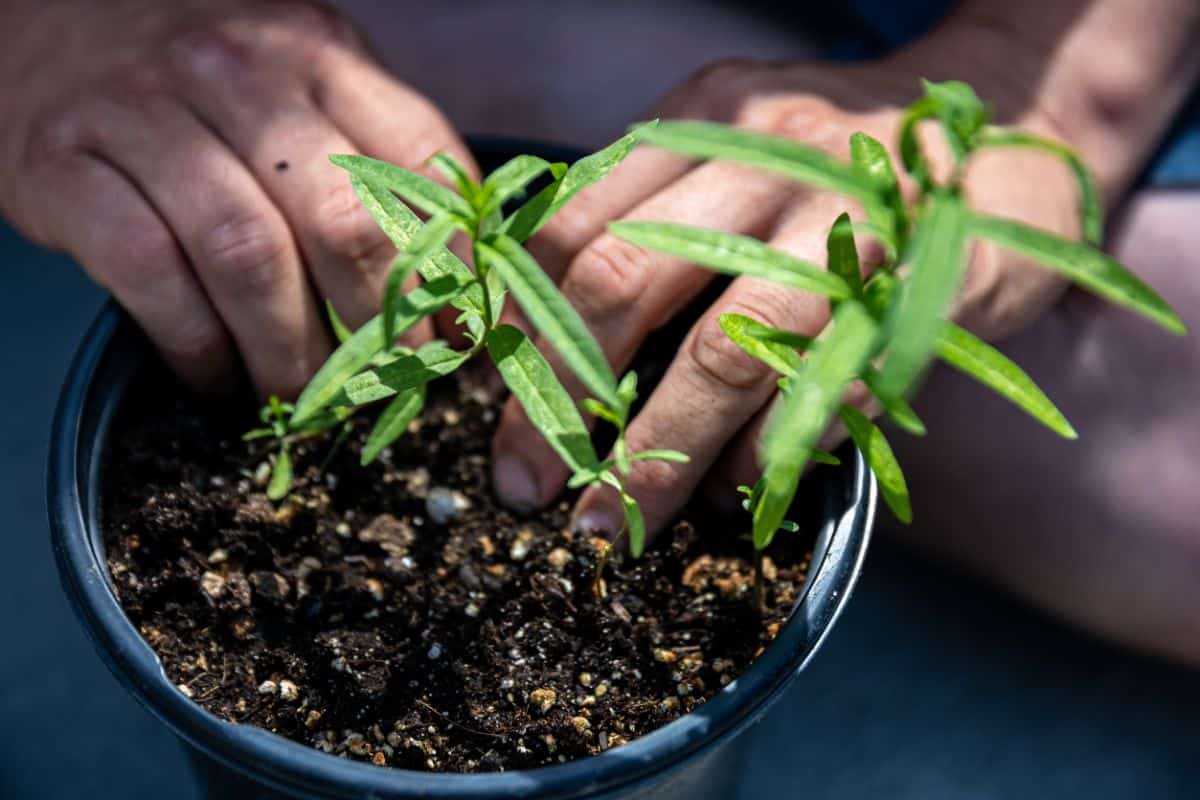
Most gardeners plant milkweeds in their flower beds, but some also plant milkweed in containers. Let’s go over the instructions for how to plant these flowering perennials. We will assume that you are using a starter plant, not seeds (see the propagation section for information on growing milkweed from seeds).
Ground Planting
1. Pick a sunny spot in your garden to plant your milkweeds and prepare the soil if necessary.
2. It is recommended that you make sure the area is thoroughly weeded before you proceed to plant the milkweeds. Work out any clumps you find as well.
3. Dig holes for the milkweed plants. 18 inches apart is usually sufficient, but with some bigger types of milkweeds, you might need to put in more space.
4. Plant the milkweeds, backfill the soil, and water well.
Container Planting
1. Begin by choosing a container that is large enough for a milkweed plant. It should measure about 16 inches across and feature drainage holes.
2. Start adding the potting mix to your container.
3. Put the milkweed inside the pot.
4. Finish filling in the soil around the milkweed, then water well.
How to Propagate Milkweeds
If you want to propagate milkweed plants, you can do so using their seeds or cuttings. You also can divide milkweed. Let’s go over the directions for all three of these propagation methods.
Starting Milkweeds from Seed
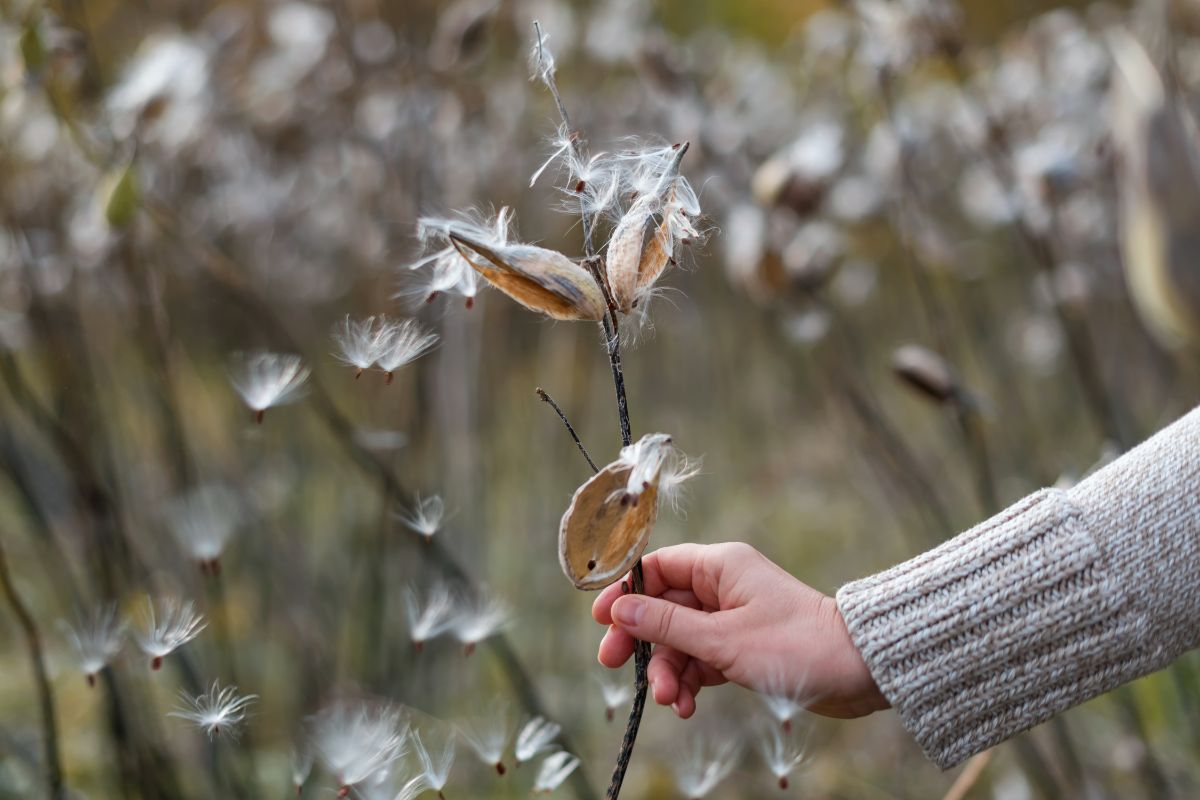
An optional step you might want to take before you proceed with those below is to soak your seeds in warm water in paper towel packets. Doing so many give you better results. Here are the rest of the steps:
1. Get plastic flats with drainage holes and fill them with potting mix.
2. Water the flats and wait for the excess water to drain out.
3. Place the seeds on top of the potting mix. Space each of them about a quarter to a half an inch away from the others.
4. Put a quarter inch of potting mix on top.
5. Use a spray bottle to moisten the potting mix. Do not dislodge the seeds.
6. Put clear plastic wrap or a cover on top of each flat.
7. Choose a sunny spot for your seeds to germinate, and/or use grow lights. The ideal temperature is 75 degrees Fahrenheit; if it is cooler than that, using a heating mat may help. Check on the seeds while they are germinating to make sure that the potting mix has not dried out, adding water as needed. The germination process should take about a week to a week and a half.
8. Take the cover off once the seedlings have sprouted. Continue to add water to the potting mix when it dries out. It is very important that you do so from the bottom.
Offering detailed instructions on this step, Monarch Watch says, “You can water from the bottom by placing the flat in a sink or a larger flat filled with 2 inches of water until moisture appears on the soil surface. The soil should be kept moist, but some care is needed to keep the seedlings from getting too wet - such conditions contribute to fungal growth that can kill the young seedlings ("damping off"). Thinning (see below) can reduce damping off.”
We recommend you drop by the site we linked above, as they provide a lot more information about harvesting milkweed seeds, stratification, heat shocking, and scarification.
9. When the plants are at least several inches tall, you can harden them.
10. Transplant the new milkweeds outdoors after the last frost.
Starting Milkweeds from Cuttings
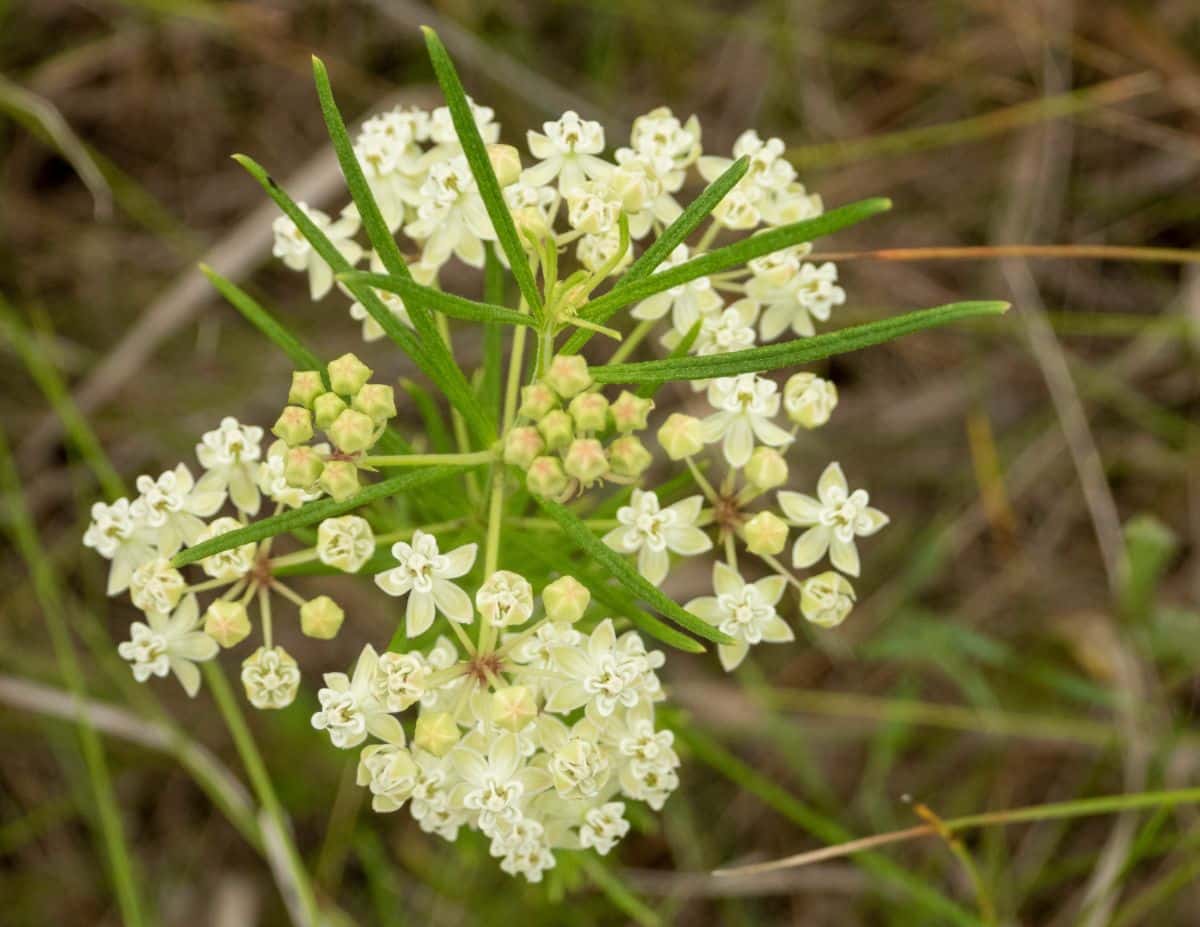
You can take cuttings from existing milkweed plants to produce new plants. Here is how to do it:
1. Take your cuttings a couple of weeks after fertilizing your plant.
2. Fill a container with moist vermiculite or sand.
3. Dip the ends of the cuttings in the rooting hormone.
4. Plant the cuttings in your container.
5. Cover the cuttings with a plastic bag that you have staked so it will not contact the plants.
6. Regularly check on the container and add water when necessary.
7. After 6-10 weeks, the cuttings should have rooted successfully.
8. Harden your cuttings, then transplant them outdoors and water well.
How to Divide Milkweeds
Divide milkweeds using the same basic steps you do other perennials in your garden.
1. Use a shovel to dig in a circle around the milkweed you want to dig up.
2. Once you have made a full circle, push the shovel under the plant to raise it up out of the soil.
3. Brush away the loose dirt.
4. Use the shovel to split the milkweed.
5. Dig holes and transplant the milkweed divisions. Backfill the soil and water well.
How to Care for Milkweeds
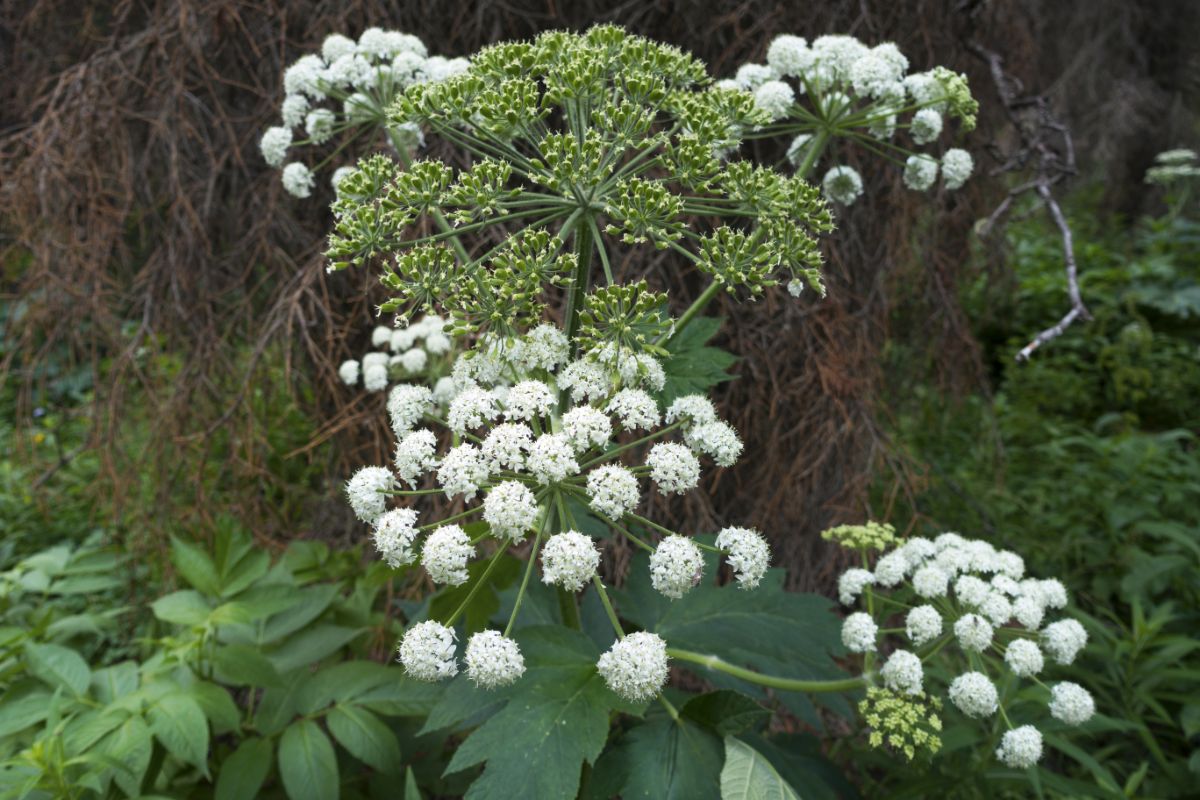
What do you need to know about maintaining milkweed? Let’s discuss fertilizing these plants, mulching them, staking them, and pruning them.
How to Fertilize Milkweeds
Try giving your milkweeds a slow-release fertilize every spring. You should only have to do this once a year.
How to Mulch Milkweeds
A lot of perennials benefit from mulching. But whether or not you should mulch your milkweeds depends on what type you have. Some need their soil to be on the dry side, while others do well in moist soil. You should only mulch the ones that can tolerate locking in the moisture.
This is one of the reasons it is so important to weed your garden beds thoroughly before you attempt to plant milkweeds. That way, you do not need to worry about mulching to keep away the weeds.
How to Stake Milkweeds
Usually, you can avoid the need to stake milkweeds simply by growing them where they will receive plenty of sunlight. But if you are still dealing with flopping plants, then yes, you can try staking them.
Regular bamboo stakes work well for this purpose. Just tie them loosely and carefully to the stakes.
How to Prune Milkweeds
Pruning milkweeds is simple and straightforward, involving a combination of deadheading and trimming back the plants for winter.
How to Deadhead Milkweeds
Your milkweeds will bloom more prolifically if you deadhead them. Once the flower clusters are spent, you can use sanitized scissors to snip them off. Make sure you are cutting above the leaves.
When to Cut Back Milkweeds
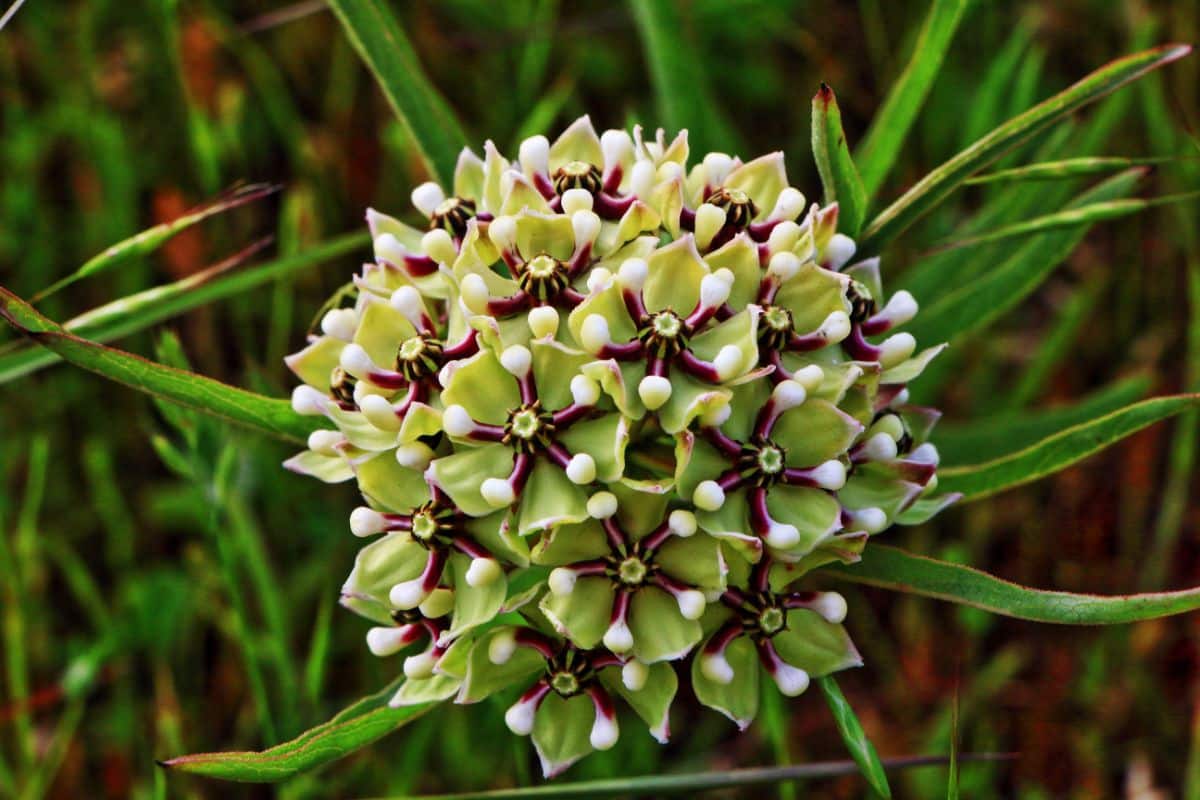
In late autumn, you can cut back your milkweeds to about 6 inches above the ground. The reason to leave so much of the stalks is because sometimes beneficial insects like to use them as shelter.
Are Milkweeds Vulnerable to Diseases or Pests?
Leaf spot, root rot and verticillium wilt are among the diseases most likely to afflict milkweed.
If you want to prevent diseases, the best way to do it is to remember that milkweeds are very sensitive to overwatering. It is better to err on the side of too little than too much. If you can manage to give them the right amount of water, it is far less likely you will have problems.
Pests can also trouble milkweeds, however. Look out for aphids, whiteflies, spider mites, scale insects, thrips, leaf miners, snails, and slugs.
You can learn more about all of these diseases and pests here, along with recommendations for what you can do if one of your milkweeds is plagued by them.
Despite the fact that milkweeds are toxic to animals (scroll to the FAQ to learn more), deer and rabbits are stubborn critters, and either or both may sometimes attempt to eat them anyway. So, that is something else to be wary of.
Recommended Planting Combinations for Milkweed
Here are some ideas for what you can plant with milkweed:
• Blanket flower: These spectacular prairie flowers are summer and autumn bloomers, and another favorite of pollinators.
• Stonecrop: This plant grows well in dry, hot conditions and loves sunlight. It blooms during summer and fall. Take a look at our Sedum Full Growing Guide to learn how to plant and care for this perennial.
• Penstemon: The butterflies that visit your garden will also enjoy this stunning perennial, making it a great option to plant next to your milkweed. It will also be a major draw for hummingbirds in your area. See our Penstemon Full Growing Guide.
Those are just a few examples. Anything that appreciates dry soil and lots of direct sunlight will be happy planted next to milkweed.
Milkweed Landscaping Ideas
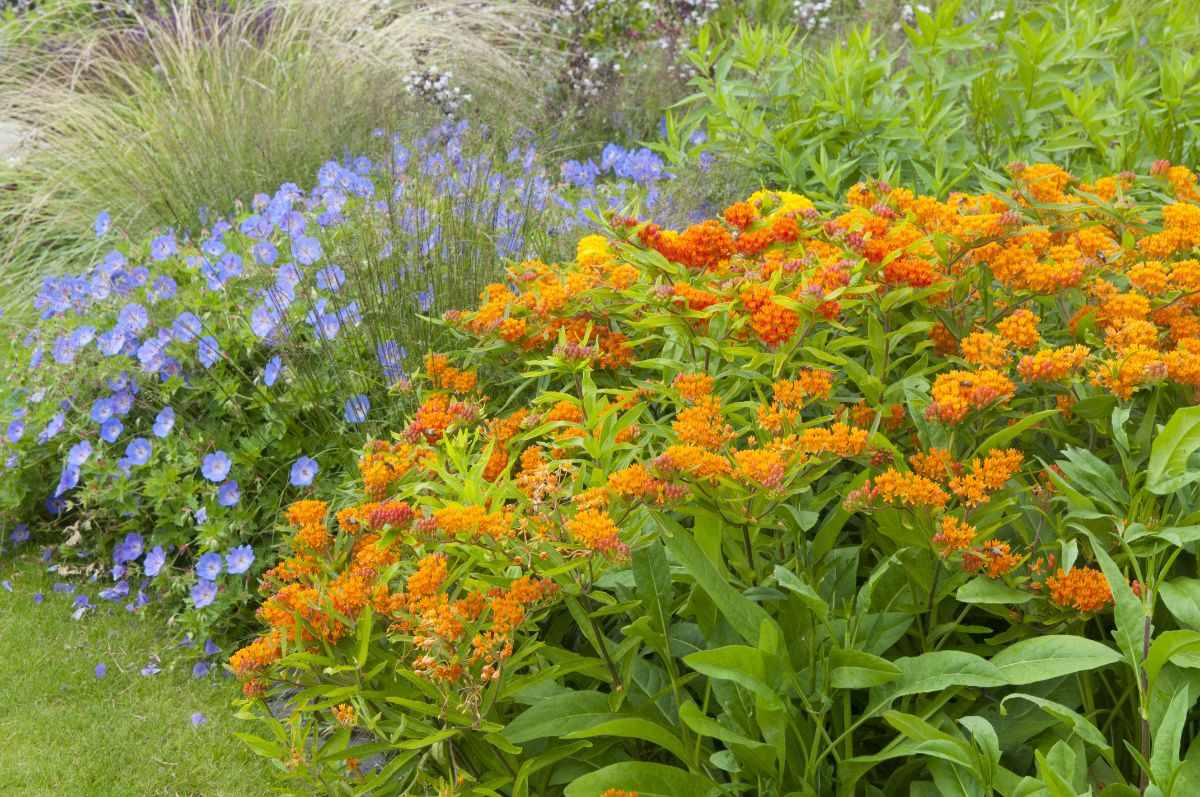
Here are some ways you can use milkweed in your landscape:
• Pollinator garden: Milkweed is an excellent addition to your pollinator garden for obvious reasons. It will attract a wide range of butterflies, not just monarchs, and the bees will appreciate it too.
• Native garden: If you are trying to cultivate a native garden, milkweed will probably be right at home. No matter where you are located in the Americas, chances are good you can find some cultivars that are native to your region.
• Cottage garden: Sometimes, milkweed is used as part of a cottage garden landscape.
• Container garden: Try growing milkweed in pots on your patio. Not only will they bring butterflies to your patio, but they will also help to bring more life and color to what might otherwise be a pretty bland and lifeless space. Plus, milkweed is especially suited to a patio garden since it can tolerate dry conditions better than a lot of other plants. It is less likely to mind the bright, hot sun reflecting off of concrete.
Recommended Milkweed Varieties
What are some types of milkweed you can get to bring beauty to your outdoor spaces while supporting the monarch population? Here are a few varieties to consider. Please keep in mind not all of them may be suitable in every geographical area. See the native ranges for recommendations.
Common Milkweed
Native range: AL, AR, CT, DC, DE, GA, IA, IL, IN, KS, KY, LA, MA, MD, ME, MI, MN, MO, MS, MT, NC, ND, NE, NH, NJ, NY, OH, OK, OR, PA, RI, SC, SD, TN, TX, VA, VT, WI, WV.
This name refers to the species Asclepias syriaca. It prefers reasonably moist soil and full sun. It will not do well in the shade. In June through August, you can look forward to beautiful clusters of flowers with a whitish-pinkish-purplish color. With its appealing appearance and its wide native range, it is one of the best choices for those growing milkweed in the US.
Swamp Milkweed

Native range: AL, AR, CO, CT, DC, DE, FL, GA, IA, ID, IL, IN, KS, KY, LA, MA, MD, ME, MI, MN, MO, MT, NC, ND, NE, NH, NJ, NM, NV, NY, OH, OK, PA, RI, SC, SD, TN, TX, UT, VA, VT, WI, WV, WY
“Swamp milkweed” is the colloquial name for Asclepias incarnata. This is the type of milkweed we mentioned does well in moist, rich soil. It can grow to be quite large and also can handle shade better than most other types of milkweed. Another name for it is “pink milkweed,” which refers to the color of the flowers. June through October is the bloom period for this species.
Butterflyweed
Native range: AL, AR, AZ, CA, CO, CT, DC, DE, FL, GA, IA, IL, IN, KS, KY, LA, MA, MD, ME, MI, MN, MO, MS, NC, NE, NH, NJ, NM, NY, OH, OK, PA, RI, SC, SD, TN, TX, UT, VA, VT, WI, WV
Butterflyweed or “butterfly weed” is the name we use to refer to Asclepias tuberose, a particularly eye-catching species of milkweed. If you are looking for a milkweed that will make a bold statement in your pots or flower beds, you will love the spectacular orangey-golden blooms of this plant. Sometimes it is also referred to as “orange milkweed.” Give it plenty of sun and plant it in dry or moist conditions, and it will reward you with flowers starting in May and running all the way until September.
White Milkweed
Native range: AL, AR, CT, DC, DE, FL, GA, IL, IN, KY, LA, MD, MO, MS, NC, NJ, NY, OH, OK, PA, SC, TN, TX, VA, WV
If you want a type of milkweed that produces white blooms, then get Asclepias variegate. While the blooms are small, they bring visual appeal and butterflies to your garden starting in May and lasting until September. It likes dry soil, but it can put up with a little shade.
Green Milkweed
Native range: AL, AR, FL, GA, IL, IN, KS, KY, LA, MO, MS, NE, OH, OK, SC, TN, TX, WV
Here is an intriguing variety of milkweed, the species Asclepias viridis. As the name suggests, it produces blooms that have a pale greenish hue in May through August. The purple centers form an interesting contrast.
Purple Milkweed
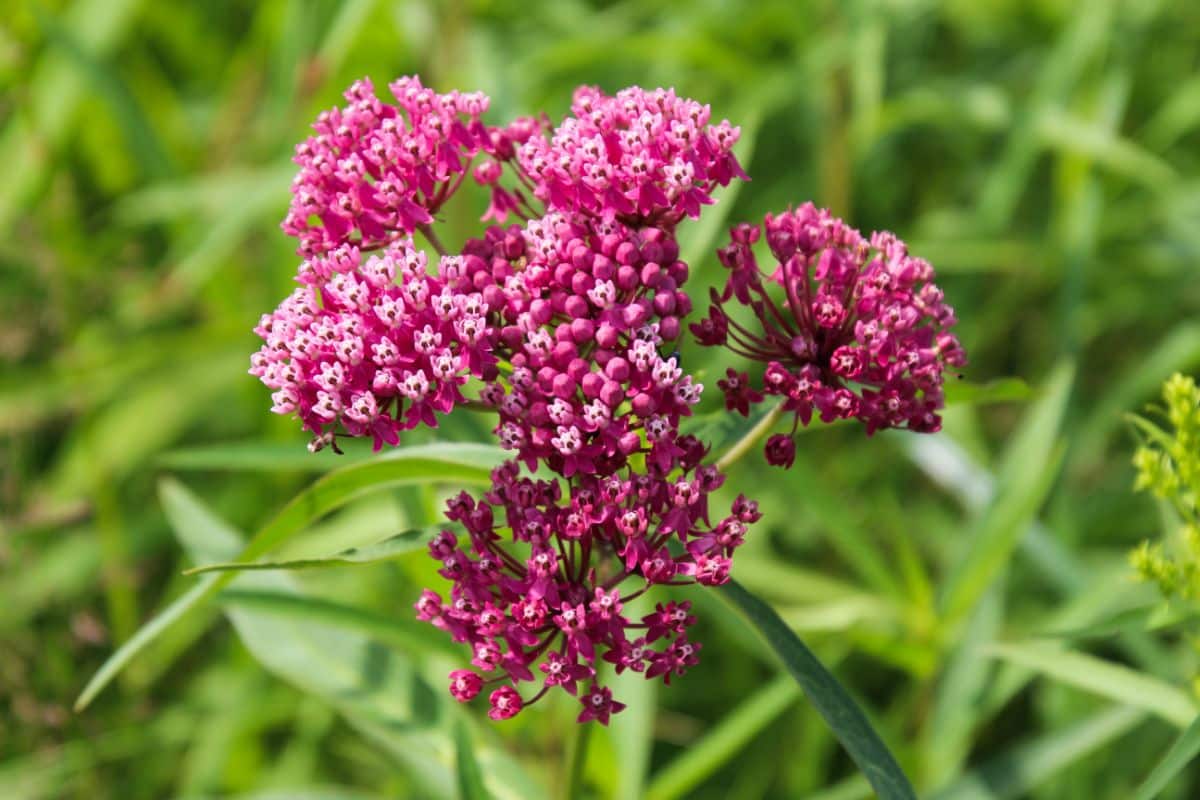
Native range: AR, CT, DC, DE, GA, IA, IL, IN, KS, KY, LA, MA, MD, MI, MN, MO, MS, NC, NE, NH, NJ, NY, OH, OK, PA, RI, SD, TN, TX, VA, WI, WV
One of the top choices for gardeners who are looking for blooms with a bold hue when planting milkweed is this one. The scientific name for purple milkweed is Asclepias purpurascens. Actually, despite its name, the color of the blooms it produces in May through July is better described as a deep pink. It will flourish if you plant it in a sunny spot with dry soil.
Showy Milkweed
Native range: AZ, CA, CO, IA, ID, IL, KS, MI, MN, MT, ND, NE, NM, NV, OK, OR, SD, TX, UT, WA, WI, WY
With a name like “showy milkweed,” you know the species Asclepias speciosa is going to be spectacular to look at. It is notable both for its large leaves as well as the dramatic clusters of pink and white blooms it produces in May through September. Do not plant it in the shade; make sure it gets plenty of direct sunlight each day. It likes moist soil.
Desert Milkweed
Native range: AZ, CA, NV, UT
While some types of milkweed can be grown through most of the US, you only will be lucky enough to grow desert milkweed if you live in one of the four states above. This species has the scientific name Asclepias erosa, and produces beautiful yellow flowers in April through October.
As you would expect, it does not thrive in the shade; give it full sun and dry, sandy soil.
Remember, there are more than 100 different species of milkweed that are native to the US! So, this is just a small sampling of the massive selection out there. Whatever colors you are in search of, you are sure to find many splendid candidates that are suited to your region.
Milkweed Varieties to Avoid
Please do not plant non-native milkweed cultivars in your garden! That means that if you live in the US, you should not plant tropical milkweed. Planting these types of milkweed outside their native range will harm the monarchs, not help them.
Additionally, there are some other types of “milkweed” to avoid. It seems that the common name “milkweed” is somewhat ambiguous and may sometimes refer to plants that are part of different genera than the one we are discussing in this post.
USDA writes, “There are a several native and introduced milkweed plants in the genus Cynanchum (swallow-worts) that are also eaten by monarchs. Swallow-worts have similar chemical properties to milkweeds in the genus Asclepias, that fool monarchs into laying eggs on them. Cynanchum species are not suitable food for monarch larvae. Caterpillars fail to develop into pupae when feeding on them. Please do not plant these milkweeds in your garden.”
Frequently Asked Questions About Growing Milkweeds
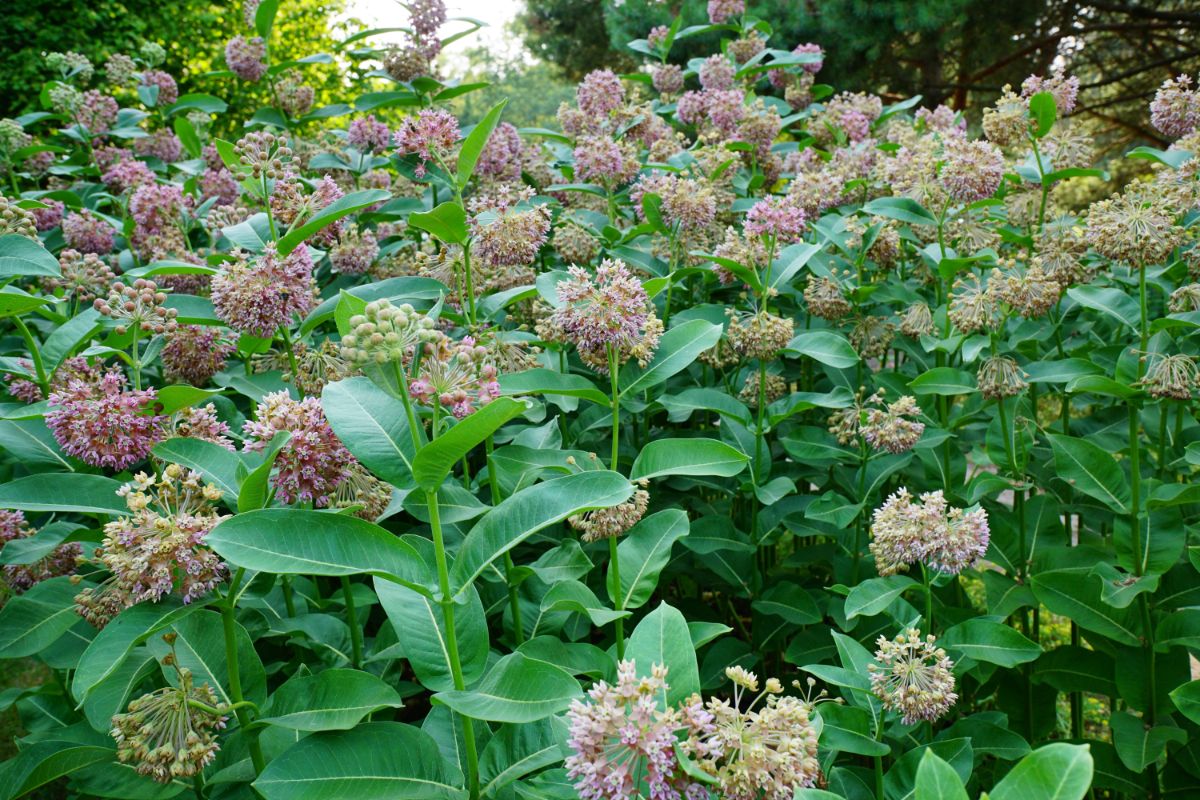
To conclude our post, let’s answer a few common questions that gardeners ask about milkweed plants.
Slugs and snails eat milkweed, as do some insects, and sometimes even deer or rabbits. With so many possible suspects, it may take you some time to narrow it down.
Some people use the terms “milkweed” and “butterflyweed” or “butterfly weed” interchangeably, but they are not exactly the same thing.
“Butterflyweed” or “butterfly weed” refers to the species Asclepias tuberosa L.
As you can see, this is a member of the milkweed genus.
So, a butterflyweed is a type of milkweed, but not all milkweeds are butterflyweeds. Try to only use the term “butterflyweed” when you are referring specifically to this specie. Otherwise, say “milkweed.”
It seems that one may eat some milkweed plants. This page at Brandeis University says, “The milky juice and the leaves are ‘bitter and mildly toxic,’ but boiling can rid the plant of both of those problems. The boiled young shoots, leaves, unopened flowerbuds, flowers, and young pods are said to be good as asparagus, cooked greens, cooked vegetables, and fritters.”
The page continues, “The only way to eat Milkweed is as a young shoot (under 15 cm), but the young shoot could be confused with dogbanes and Butterfly-weed, which are both poisonous!”
Well, that is confusing—butterflyweed is a type of milkweed, so this appears to be a contradiction, despite coming from an academic source.
Plants for a Future provides some added perspective regarding butterflyweed, explaining, “Whilst most parts of this plant have been used as food, some caution is advised since large doses can cause diarrhea and vomiting.”
The site goes on to explain what the shoots, flower buds, and seed pods taste like. It also points toward some additional culinary opportunities: “Flower clusters can be boiled down to make a sugary syrup[2, 4, 85, 183]. In hot weather, the flowers produce so much nectar that it crystallizes out into small lumps which can be eaten like sweets; they are delicious.”
Plants for a Future also says that some sources claim the root of butterflyweed is poisonous. So, you may want to steer clear of milkweed roots. Aside from that, the best recommendation when eating milkweed seems to be “approach with caution, boil the milkweed parts you are consuming, and do not eat large amounts.”
The National Capital Poison Center gives a far less rosy outlook on consuming milkweed, writing, “All parts of the plant contain toxic cardiac glycosides, which can cause nausea, diarrhea, weakness, and confusion in small amounts, and seizures, heart rhythm changes, respiratory paralysis, and even death in large amounts.”
If you or someone else does suffer a toxic reaction, symptoms will become evident within hours of consumption.
We are not medical experts, so if you decide to eat any part of milkweed, you do so at your own risk.
You may irritate your skin and eyes handling milkweed sap. Washing with soap and water can help to treat skin irritation. Eye exposure needs to be treated with a 10-15 minute rinse.
Yes, milkweed is poisonous to cats and dogs. It is also poisonous to horses, sheep, and other animals. Keep pets away from milkweed, and never let your animals graze on it.
A clump of milkweed can reach a height of up to 6 feet (although 5 feet is more typical), and measure about 3 feet across. For that reason, you should space apart plants sufficiently. Some types of milkweed are bulkier than others; swamp milkweed, for example, needs about 30-36 inches of space between plants, whereas 18 inches is adequate for most other types of milkweed.
Milkweed is an herbaceous perennial. That means that it blooms every year in your garden, inviting butterflies and other pollinators and delighting you with its beautiful flowers.
Where to Buy Milkweeds
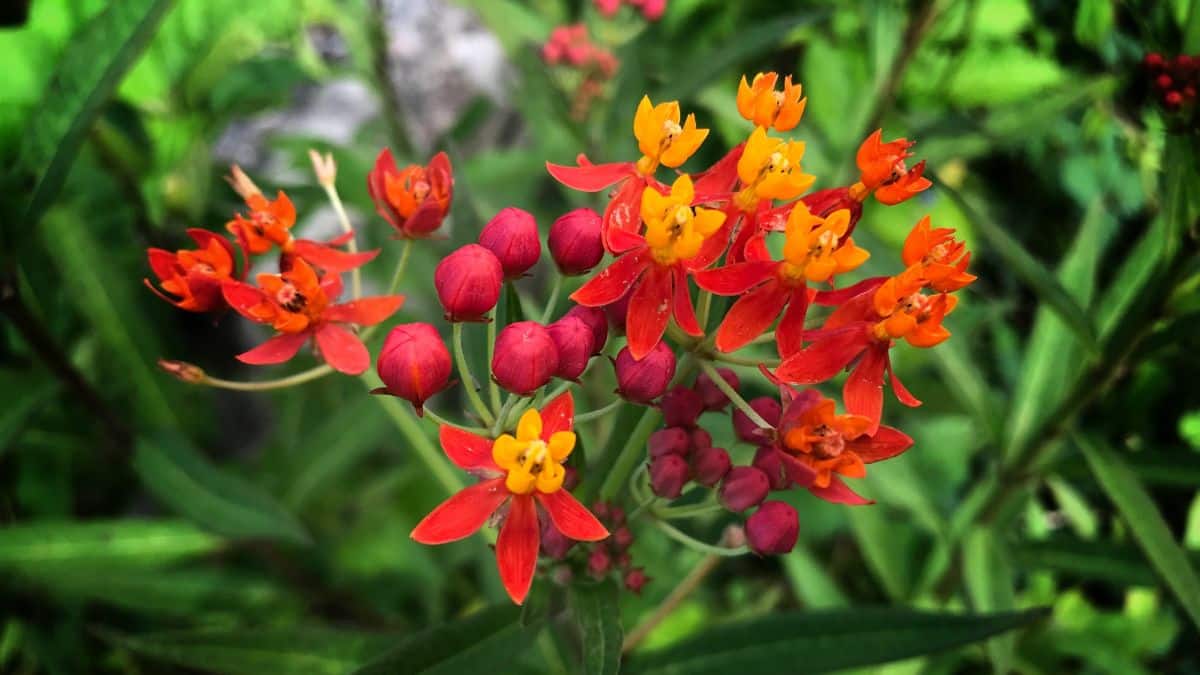
To shop the largest selection of milkweed, you will need to go online. Care for your milkweed using what you have learned in this milkweed growing guide, and you can look forward to years of stunning blooms and happy butterflies.


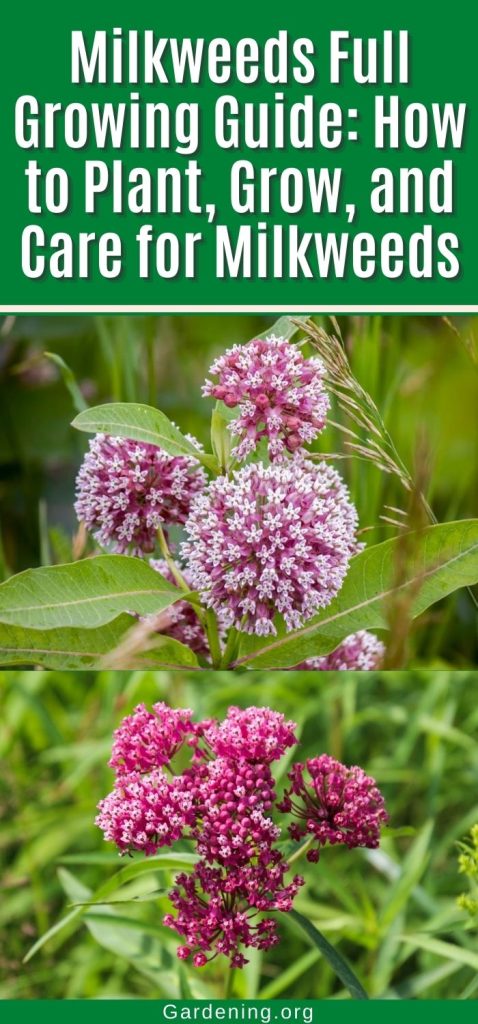

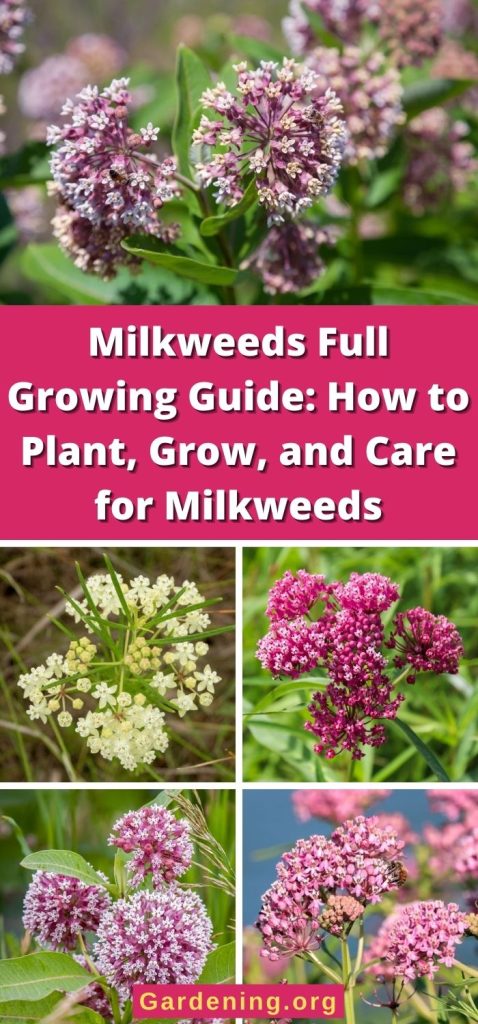

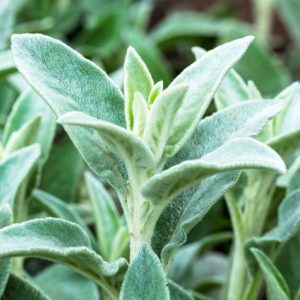


Leave a Reply